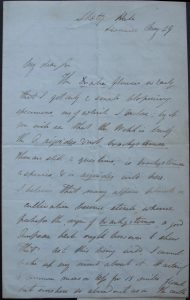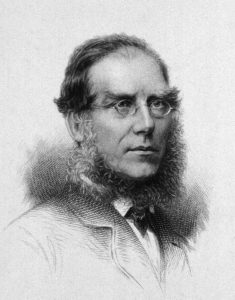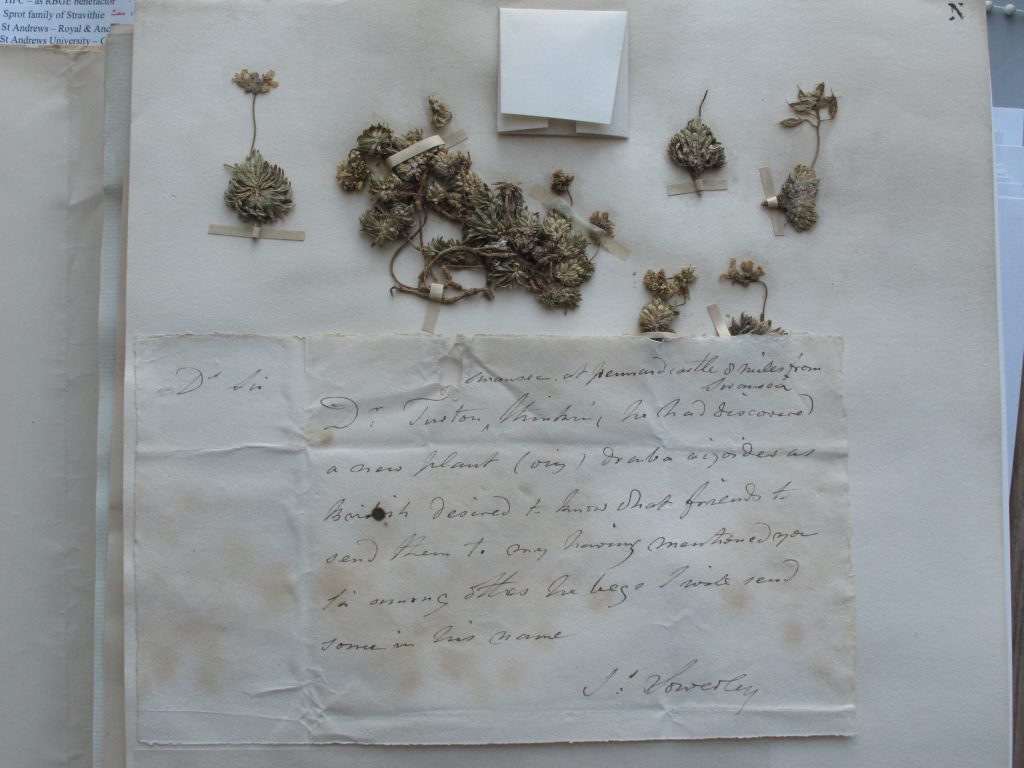 The most glowing review of Cleghorn’s (frankly rather dull – his father uncharitably told him that it would ‘drive all other soporifics out of fashion’) 1861 Forests & Gardens of South India was penned by Joseph Hooker. So it was rather curious that a letter by this great, if decidedly unlovable, Victorian botanist should turn up at RBGE at the end of my Cleghorn project.
The most glowing review of Cleghorn’s (frankly rather dull – his father uncharitably told him that it would ‘drive all other soporifics out of fashion’) 1861 Forests & Gardens of South India was penned by Joseph Hooker. So it was rather curious that a letter by this great, if decidedly unlovable, Victorian botanist should turn up at RBGE at the end of my Cleghorn project.
When going through the RBGE Illustrations Collection some 15 years ago, taking out all original drawings, but also many of the rarest prints, for safer storage, I also removed some miscellanea that demanded further study. From time to time, usually between other projects, I return to this stash: and as a result of knowledge acquired since my last look, something almost always leaps out as being of interest.
So it was on Friday. The illustrations are stuck onto herbarium sheets and had been arranged taxonomically by Family, genus and species; the sheet in question bore two images of the crucifer Dentaria diphylla – in a combination characteristic of the diversity of the collection, a hand-coloured engraving from the Botanical Magazine and a photograph from a cheap horticultural periodical. The reason I had extracted it was neither of these, but the third item attached to the sheet, a letter in the distinctive handwriting of Joseph Dalton Hooker, written from Sketty Hall, Swansea on the 29th of May in an unrecorded year. The plant referred to in the letter was denoted ‘D. aizoides’, but to anyone familiar with British botanical rarities, this could mean only one thing – a crucifer, to be sure, but belonging to an altogether different genus, Draba.
The letter is a gem. Quick reference to Mea Allen’s excellent (if ambiguously titled) The Hookers of Kew immediately supplied the missing date, 1846. In the May of this year Hooker was working in South Wales for Henry De La Beche of the Geological Survey (who lived in Swansea), studying plant fossils of the Coal Measures. It was an interesting stage in Hooker’s life: between his great Antarctic Voyage (he was still on the payroll of the Royal Navy, writing up his Antarctic Flora), and two years before his great Himalayan Excursion. There are interesting family links, as at Sketty Hall he was staying with Lewis Weston Dillwyn, who was not only a close friend of De La Beche (a Dillwyn son married a De La Beche daughter), but an even longer-standing friend of Hooker’s own grandfather, the Yarmouth banker, art collector and botanist Dawson Turner. In 1805 Dillwyn & Turner had collaborated over the Botanist’s Guide, and in 1839 Dillwyn had produced (its title page paradoxically stating that it was ‘not published’) a ‘Review of the References’ to Rheede’s Hortus Malabaricus, In 1853 this was one of the books that the London bookseller William Pamplin sent to Hugh Cleghorn in Madras to start to rebuild his recently incinerated library. The work would be useful as Cleghorn’s copy of the Hortus Malabricus was one of his few books to be rescued from the flames (see earlier Botanic Story).
In May 1845, exactly a year before this letter was written, Hooker had been in Edinburgh, lecturing at RBGE for the terminally ill Robert Graham, who had died, in embarrassed financial circumstances, that August. In the meanwhile there had been an unedifying episode over the succession to Graham’s botanical chair – Hooker was never particularly keen on the idea of obtaining it (his ambitions were MUCH bigger), but his father and the entire international botanical community, from Alexander von Humboldt downwards, thought he should have it. But chauvinist Edinburgh Town Councillors gave the job to the local boy, the evangelically-minded John Hutton Balfour.
The letter refers to the purchase of botanical books from Graham’s widow, and it is this that gives a clue to its anonymous recipient. In Graham’s last illness his physician was Charles Ransford, who wrote his patient’s obituary (a rather disappointing one, botanically speaking) which was read as the annual Harveian Oration in 1845 – doubtless the ‘memorial’ referred to in the letter that Hooker would see when he got back home (that is, to his father’s house at Kew). This pamphlet is still at Kew, inscribed ‘from the Author’. In the letter Hooker offers advice on the purchase on behalf of some ‘college’, from Mrs Graham, of two fine illustrated botanical works. The professor’s library and herbarium was his own personal property, and all had to be auctioned to pay off the debts, a great loss to RBGE . This doubtless refers to the Edinburgh Royal College of Physicians, in which Ransford was heavily involved at this time. One of the books was by William Roxburgh, and from its price (£12), this implies the magnificent elephant folio Plants of the Coast of Coromandel. The other was a compete set (36 volumes + supplements) of English Botany, with text by John Hope pupil James Edward Smith, though generally attributed to its illustrator James Sowerby.
In the 18th volume of English Botany (February 1804), the pretty little, yellow-flowered rosette plant Draba aizoides was illustrated by Sowerby. He drew it from a collection sent to Smith in 1803 by Dr William Turton of Swansea, who had collected it on the walls of Pennard Castle, one of the sites discussed here by Hooker. In fact Turton (better known as a conchologist) was not the plant’s discoverer – he had been shown it by John Lucas of Stouthall, who had first found the plant in 1795, a fact first published by another pupil of John Hope, in the 8th edition of William Withering’s (scantily illustrated) Arrangement of British Plants. When looking into the history of any plant at RBGE, it is essential to visit not only the library, but the herbarium. Which is exactly what I did, only to discover, pinned to one of the sheets, a second remarkable letter relating to the diminutive (and over-collected) Draba. This one was written by none other than James Sowerby himself, presumably in 1803 when sending a specimen to Lt Col James Brodie of Brodie, a botanically minded Morayshire laird and Member of Parliament, whose herbarium is an important part of the British herbarium of RBGE.
The final noteworthy point in Hooker’s short letter relates to his interest in plant distribution, history and geography – matters on which he would become a major authority for, and influence on, Darwin. Such matters are raised not only with respect to the indigineity of the Draba, but to a group of plants alleged to have been found in the Scottish mountains, 40 years earlier, by George Don. Recent genetic analysis has confirmed Hooker’s belief that in Wales the Draba is a native – the population strongly disjunct from its Central European distribution, presumably the result of a one-off dispersal event (and subsequent evolution) – of the sort that Darwin tended to be suspicious. The Don plants mentioned are also of interest because, for a short time (1802–8), Don was Superintendent of RBGE, and inhabitant on Leith Walk of the Botanic Cottage that has recently been rebuilt at RBGE. Two of the Don rarities mentioned by Hooker had made it into English Botany, Stellaria scapigera forming the previous-but-one plate to the Draba, which makes one wonder if Hooker had been looking at the book and reminded of the controversy. History has supported Hooker’s view that Don had probably mixed up the origin of these plants: that they had been growing in his garden (a botanic garden in Forfar), but their origins had been confused in his mind and that they actually came from abroad.
Here are transcripts of the two letters:
Joseph Dalton Hooker [probably to Dr Charles Ransford]
Sketty Hall
Swansea May 29 [1846]
My dear Sir
The Draba flowers so early that I got only 2 small blossoming specimens, one of which I enclose: by it you will see that the Welsh is truly the D. aizoides & not brachystemon. There are still 2 questions: is brachystemon a species, & is aizoides wild here. I believe that many alpine plants on cultivation become sterile, whence perhaps the origin of brachystemon, a good European herb. ought however to shew that. As to its being wild, I cannot make up my mind about it. It certainly is common more or less for 15 miles of coast but nowhere so abundant as on the castle walls. It may thus be only spreading from the said walls along the coast. Still I am willing to give it the benefit of the [?out] & I agree to its being wild. Dillwyn’s opinion is very wavering. This not a plant likely to have been introduced by the Barons bold who once held the castle. Considering the nature of the rock, so very favourable for Southern plants & the accompanyment of the Cistus canus certainly savage, we must I think allow the Draba to be native too.
Your lecturing plan is good. As to giving up a Summer course which you once proposed, you will remember that some bodies demand a Summer course
I still think that Engl. Bot. was marvellously cheap, however much cheaper copies have gone: for it is a work always in some demand, & if you could get it bound as that was for £5 “ 8 it is more than we could here. It had the supplements too. As to its being worth £31.” 10 to you, that’s quite another affair, it is not worth 31L to me.
Certainly do not once think of Roxburgh for the College if you can get it cheaper elsewhere. I will propose the £12 to Mrs Graham, though remember that the price she may expect is not exactly what the college, which can get any book cheaper than other people, would give as she does not offer it to colleges alone.
I expect that whole lots of Don’s plants were garden specimens; & that he mistook some of his foreign things for what he had gathered on the mts. whence Stellaria scapigera, Tussilago alpina, Ranunculus glacialis, Potentilla tridentata cum paucis aliis.
I should like much to see your Memorial & shall when I get back with some regard to Mr Arnott & your family
Ever most truly yours
Jos D Hooker
Bessy is better at Bishopstoke & coming home next week. I do wish you were here, I should enjoy a cruise with you vastly
James Sowerby to James Brodie of Brodie [1803]
Dr. Sir
Dr Turton of Swansea at Pennard Castle 8 miles from Swansea thinking he had discovered a new plant (viz) Draba aizoides as British desired to know what friends to send them to my having mentioned you Sir among others he begs I will send some in his name
Js: Sowerby
Lieutt: Coll: Jams: Brodie M.P.
No 29- Suffolk Street
Haymarket


